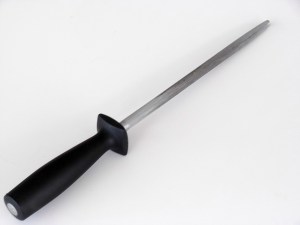While this happens to be the title of a wonderful book by Kathleen Flinn (which I read  prior to going to culinary school), it also happens to be one of the most important lessons in the kitchen.
prior to going to culinary school), it also happens to be one of the most important lessons in the kitchen.
Most kitchen injuries result from using a dull knife. If your knife is properly and regularly sharpened, you will both increase your efficiency and significantly reduce your risk of cutting yourself.
Knife maintenance consists of two steps:
1. SHARPENING YOUR KNIFE
Whenever your blade begins to dull, use a sharpening stone to  regrind your blade and restore its edge. Most cookware stores will offer the three most common stone options: oil, water or diamond. While diamond is the most durable, it is also the most expensive. Oil is the second most durable. However, it cuts more slowly and is a mess to clean up. Personally, I prefer a water stone like this one: http://www.jbprince.com/knife-sharpeners/comb-waterstone-1000-and-6000.asp
regrind your blade and restore its edge. Most cookware stores will offer the three most common stone options: oil, water or diamond. While diamond is the most durable, it is also the most expensive. Oil is the second most durable. However, it cuts more slowly and is a mess to clean up. Personally, I prefer a water stone like this one: http://www.jbprince.com/knife-sharpeners/comb-waterstone-1000-and-6000.asp
Here’s how to use it:
- Drizzle water across the stone
- Hold the heel of the blade at a 20 degree angle (for Japanese knives, you may need to use a 10 degree angle) against the stone
- Draw the knife toward you, from heel to tip, in light, even strokes
- Repeat on the other side starting with the tip of the blade at a 20 degree angle and push the blade away from you while maintaining light pressure
- Repeat this process 10-20 times, moving across the stone from the coarser grit side to the fine grit side of the stone, until the blade is sharp
- Here’s a great video from SharpeningSupplies.com for those of you who are more visual: http://www.sharpeningsupplies.com/freehand-sharpening-video.aspx
2. HONING YOUR KNIFE
Using a steel, honing removes microscopic broken pieces and  realigns the remaining ground edges. In order to properly maintain the edge on your knife, you will need to hone your knife after sharpening and every time you use the knife. This will minimize how often you’ll need to sharpen. To hone properly:
realigns the remaining ground edges. In order to properly maintain the edge on your knife, you will need to hone your knife after sharpening and every time you use the knife. This will minimize how often you’ll need to sharpen. To hone properly:
- With your fingers of your non-primary hand protected under the steel’s guard, position the steel in front of your body
- Hold the blade with your other hand at a 20 degree angle
- Alternating sides for 5-10 strokes, touch the heel of the blade to the top of the shaft and draw the entire blade of the knife down the shaft in a sweeping motion until the tip ends up just above the guard
- Here’s another great video – this one from CHOW – for the more visually-inclined: http://www.chow.com/food-news/55301/how-to-hone-a-knife/
After completing your sharpening and honing, test your knife by cutting into a tomato. If it cuts easily through the tomato’s skin, mission accomplished. For more on knives and my other favorite tools, visits my Tools page.
